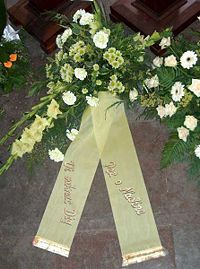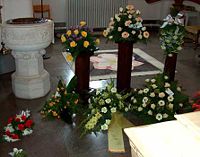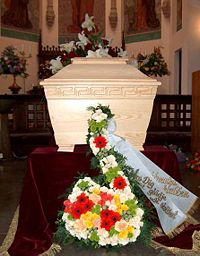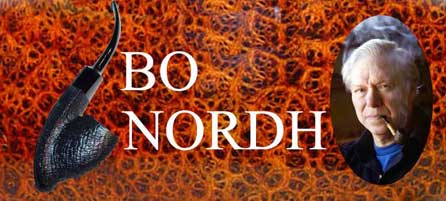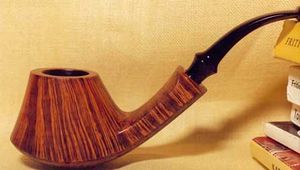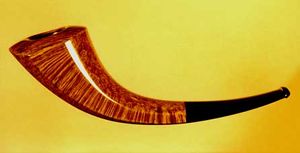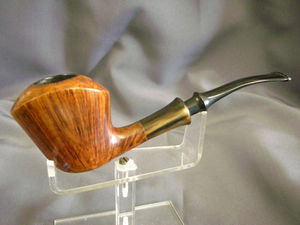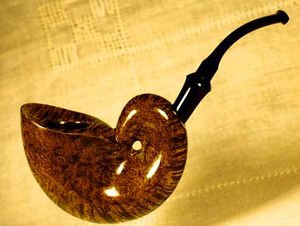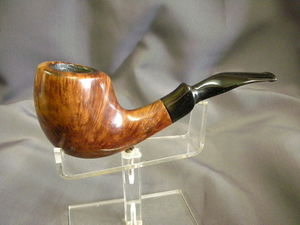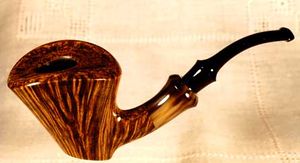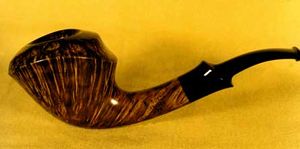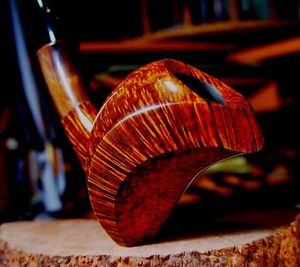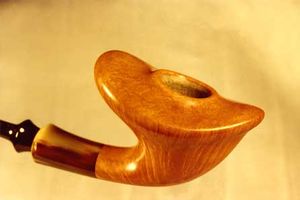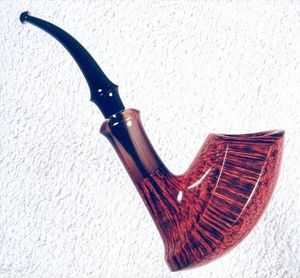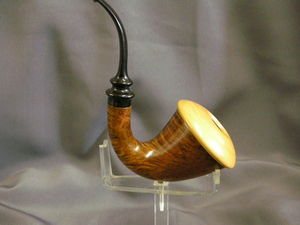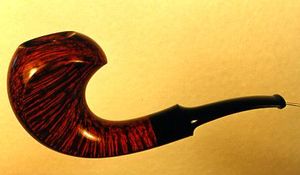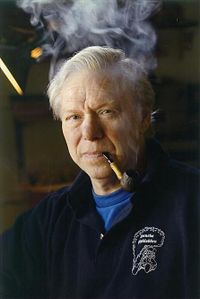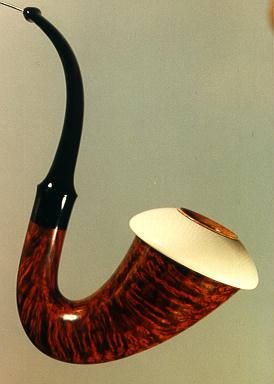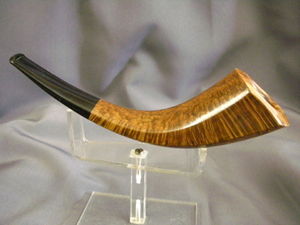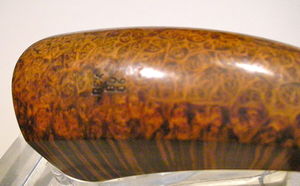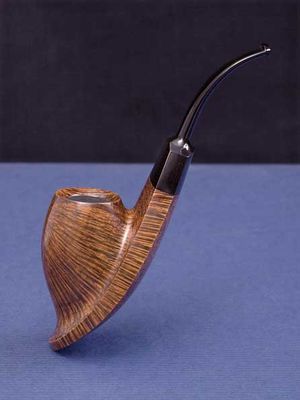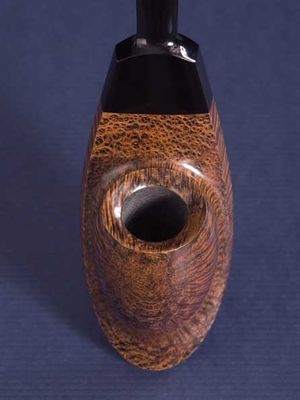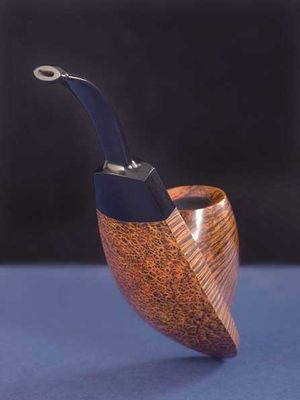Nordh
Announcement: Jan Andersson, secretary of the The Pipe Club of Sweden, has written a book on the legendary Bo Nordh entitled "Bo Nordh, Pipemaker". It is written in English with a limited run of 500 copies printed in Sweden. The author will debut the book at the Chicago pipe show this May (2008) at a price of $39 USD. Afterward the book will be distributed in the U.S. by Ben Rapaport at a price yet to be determined. It is also currently available through Briar Books Press
Broken Pipe, a Tribute to Bo Nordh by Jan Andersson
Written Sept. 2006
The Swedish pipemaker Bo Nordh passed away on the 12th of July [2006] after a short period of illness. Bo was one of the most talented and respected pipemakers of our time and he will be deeply missed by colleagues, collectors and friends from all over the world. He became 65 years old. The reason for Bo to start making pipes was in fact a tragedy. In his youth he had a terrible motorcycle accident, and the injuries from that tied him to a wheelchair for the rest of his life. He was educated as an engineer, but in his situation it was not easy to find a job. So, being a pipesmoker and in great need of something to do, he started carving pipes. Today we all know what became of that hobby.
Bo was a fighter and he really needed to be one, because his life was not easy. You may think that being tied to a wheelchair is enough trouble for one person during a lifetime, but for several years Bo also had great problems with his skin, especially in the hands. For long periods that made it very difficult for him to work, but Bo was as focused to conquer that illness as he was in making perfect pipes, so he finally succeeded. A few years ago he had a stroke and after that he got problems with his fine motor ability, a serious problem for a pipemaker. But Bo trained energetically and conquered that too. However, the cancer was too much, even for a fighter like Bo.
Bo had several hobbies besides his pipemaking. One of them was cultivating roses, and to walk around in his garden during the season was a delight. And Bo knew all there was to know about every single species. He also took a great interest in cooking and his Weber-grill was a favourite. Bo never cheated as a pipemaker nor did he do that when cooking, so every meal made by Bo was delicious, to say the least. He also took a great interest in music and his collection of CDs was huge. He favoured jazz but often also listened to classical music like Bach and Vivaldi. He had an excellent stereo in his living-room and his last improvement was to install another stereo in the workshop. Unfortunately he never got time to enjoy it, as it was installed shortly before he was taken to hospital.
Bo was a founder member of the Pipe Club of Sweden and took great interest in the club’s activities. Every summer the board of the club was invited for a meeting at Bo’s place, meetings that always ended with a delicious meal. We were all very much looking forward to these events in Bo’s home, but we also think Bo enjoyed having us as guests. We will remember Bo not only as a great pipemaker but also as a very dear friend. Bo was a very humorous person and there always was a lot of laughter when he was present. As said before, Bo had a lot of trouble during his life, but he never complained. Even during his last weeks in hospital he did not, even though he knew it was serious. He was realistic, but had not lost his hope.
We will miss Bo a lot, but we will never forget him. And we are sure that neither will he or his pipes be forgotten by pipesmokers, collectors and friends from all over the world.
A short bio on Bo Nordh By Jan Andersson
Written 1994
It is a beautiful winter day, the coldest day so far this winter. I am sitting in the cosy warmth of my car, the pipe is lit and I am full of expectations. I am on my way towards Landskrona and I am attentively looking for a sign stating "Hällstorp". It suddenly appears. I turn into a small gravel road and stop in front of a half-timbered farmhouse half a kilometre further up the road. The buildings occupy three sides and the fourth is a wall. In that way you get a built-in outside yard, a common way of building on the windy plains of Skåne, the very southern part of Sweden.
In this charming and cosy building lives Bo Nordh, a man who in the art of making pipes can be regarded as equivalent to Ingemar Stenmark when it comes to downhill skiing and Björn Borg when it comes to tennis. He lives here with his wife Birgit and two boston terriers and this is where he has his pipe workshop.
Bo is sitting in his workshop and is busy finishing some sand-blasted pipes. After having been fairly forcibly welcomed by the two dogs I can sit down. This is a conversation that will last all afternoon and I still feel when I have to leave, that we have not covered half of what I wanted to talk about. But it is often like that when pipe-enthusiasts meet - there is no end to the topics.
The Making of the First Pipe
Bo started to smoke when he was 15 years of age. He was not much of a connoisseur then, but who is at that age? He smoked "Dollar-pipes" and cheap tobacco. However, in the beginning of the 70's he became interested in what he filled his pipe with and to a certain extent what the pipe looked like. The Danish magazine STOP was just introduced and Bo read with interest about various types of tobacco and nice pipes. He started to try different mixtures which he bought from PIP-LARSSON, a famous shop in Malmö.
At PIP-LARSSON'S they also sold ready-drilled blocks for amateur pipe-makers. At this time Bo had just graduated as an engineer in machine-technology and had not yet got a job. One day his wife Birgit suggested that he should buy some blocks and make a pipe himself. The reason was that she thought Bo needed something to do.
So Bo bought two blocks and started to work on them with the tools he had at hand. As he was filing and grinding he found more and more faults in the wood. This he could not tolerate so he carried on filing to get rid of the faults. New faults appeared and in the end there was not a lot left of the block, at least not enough to make a pipe. New blocks were bought but the result was the same. After some time Bo realized that he could not go on like that.
Apparently all blocks had larger or minor faults and the only way was to adapt the design of the pipe in such a way that the faults were avoided.
This improved things no end and after that he went regularly to PIP-LARSSON for more briar blocks.
The First Bo Bordh Pipes Sold
The owner of PIP-LARSSON was Olle Jonsson. He became curious about the amount of blocks bought by Bo and one day he asked what he used them for. "Making pipes of course", answered Bo. "Bring them here so I can have a look at them," retorted Olle Jonsson who himself repaired a lot of pipes and thus had some knowledge on the subject.
At his next visit Bo brought some pipes and Olle Jonsson was delighted. "Get yourself a stamp," he said, " and I will display them in the window." Bo Nordh's pipes did not stay there long - they sold fast.
Bo Nordh Meets Sixten Ivarsson
Sixten Ivarsson lives in Copenhagen. He is the man who most likely has been more influential than anyone else when it comes to making pipes in Denmark and Sweden.
Olle Jonsson knew Sixten and he urged Bo to go to Copenhagen and meet him. The meeting took place in Sixten's workshop and turned out to be very important. Apparently Sixten immediately realized that this was a man with real talent. But he also found that Bo did not have any knowledge of the many details you have to take into consideration when you make a pipe which is not only beautiful but also smokes well.
Sixten generously shared his know-how and his experience and he also introduced Bo to the right places to obtain good raw material.
Bo Nordhs Pipes Reach Japan
Sixten Ivarsson's workshop is conveniently situated next to Ströget in Copenhagen. Here there was (and is) a steady trickle of all sorts of pipe enthusiasts from interested tourists to buyers from all over the world. Sixten Ivarsson has never been able to meet the demand for his pipes so he had to have a rationing system for the buyers. One day a Japanese saw Bo's pipes, became enthusiastc and bought them all. Not long after he contacted Bo and wanted to buy more.
Bo now started to realize that this might be something for the future for him. It might even be possible to make a living by making pipes.
His First Workshop
Bo bought the machines he needed and started to build up his own workshop in Landskrona. His training as a mechanical engineer was very useful when it came to adapting the machines to his requirements. When the workshop in Landskrona was ready he never looked back. Bo has never had any problems selling his pipes. Rather the opposite as the buyers have been knocking on his door to buy.
The first time I visited Bo was in 1981 when he was still in Landskrona. Bo then told me with sparkling eyes that he had bought an old farmhouse fifteen kilometers outside the town and that he would soon move there. It was apparently the dream of his life that came true when he and his wife bought this house and it is not difficult to understand that they like it here.
Fifty Pipes a Year
Bo's production has never been large - about fifty pipes a year and today more likely thirty than fifty. I asked a bit surprised if he did not make more in the beginning. It must be tempting when you are new in the business and the buyers just want more and more pipes. Bo, however, denies this and the explanation is of course his attitude to quality, which is free from compromise, a second nature to Bo. He would never dream of selling a pipe which he is not entirely happy with however insistent the buyers are.
No Trends
A Bo Nordh pipe is usually a combination of briar and ebonite. Trends like inlay of various types of wood in the stem or the shank has never appealed to Bo. Neither does he make the stems in acrylic, man-made amber or any of the other materials, which are so popular these days.
There are, however, certain materials in addition to briar and ebonite which have found favour after critical investigation. Horn is used in certain insert (military) pipes. "A sensitive and difficult material which requires to be stored for a long time in order not to crack," says Bo. Bamboo is sometimes used, often because he has found a fault in the shank of an otherwise nice pipe. Boxwood is also used but mainly in the Calabash-model where the cup is a combination of briar and boxwood. "But there are times," Bo confesses, "when I have made an insert pipe of boxwood instead of horn. But that has happened when I have been in a hurry and not found a suitable piece of horn."
So there have been occasions when someone has managed to stress Bo, at least a little.
The Material is Treated with Care and Respect
Bo has an enormous stock of raw materials considering his small output. He has a couple of large tin boxes full of horn, cut into suitable pieces and waxed to prevent cracking. Another box is filled with bamboo, so beautiful that I have never seen anything like it. On the shelves there is boxwood which comes from a very old tree. It has been here for twenty years.
Most important are, however, the briar blocks. They are found all over the workshop in baskets and boxes, all ground, classified and dated. There are not just a few but stacks of blocks, so tightly grained that I become almost lyrical when I see them. Many have been here for fifteen or twenty years. "It is because I cannot decide which particular model I shall make from that particular block," says Bo. A block must, however, have been in Bo's possession for at least five years before he makes a pipe out of it.
How to Store Briar Blocks
When Bo receives a new shipment of briar he first roughly grinds all blocks on the smooth side. The knotty side is brushed with a steel brush. Bad blocks are thrown out, the rest are stored in one of the neighbor's cellar to ensure that all water evaporates slowly. They are then moved to Bo's cold storage and in the autumn, when the temperature is about the same outside and inside, they are moved into the workshop. "You have to sneak them into room-temperature," as Bo expresses it. He then grinds them finely and classifies them after which they stay in storage for at least 3-5 years. Many, as I said, stay there considerably longer.
When I ask him if it really is necessary to store the blocks for such a long time Bo answers that this is the time it takes for the blocks to dry out completely and for the pores to close. If they are used earlier the wood shrinks when the pipe is ready, which can be noticed as the tenon will not fit very well.
To "Read" Wood
Bo takes down one briar block after another. To me they all look perfect, but Bo points and explains: "Here you see a failed annual ring which will have brought with it lots of faults," he says. On another block he shows me lines and areas on the knotty side which conceal bad areas or sections with thin graining inside the block. Nothing is shown on the outside that I can see, but Bo knows what he will find when he starts grinding. You could say that he reads the blocks like I read a book. It is of course based on long experience, but I also believe that it requires quite a bit of inborn talent.
Of course it is not that simple even for Bo. He does not know everything that is concealed in a block. He is subjected to surprises as well and about every second block will never become a pipe. Briar is indeed a difficult material.
The Pipes are Drilled by Hand
Bo finishes the pipes completely, he even polishes them, before he drills them. The reason is that he does not want to have any restrictions when he designs the pipe. He often has to change the design as he grinds as new faults appear.
When the pipe is ready the tobacco hole is drilled first and then the hole for the tennon, lastly the smoke channel. Bo has, by experimenting, found a method which is so reliable that he has never been unsuccessful when drilling a pipe. One has to remember that Bo is never careless or hasty, at least not when he makes his pipes.
He demonstrates the entire procedure to me, but it is a bit to complicated to describe here.
All Details Must be Perfect
It is not likely that there is one detail in the construction of a pipe that Bo has not investigated. And if there was something with which he was not very happy, he has found a better way to do it.
On pipes with a shank of bamboo or horn the standard method is that they are fitted with a metal tube. In Bo's opinion there is a risk that they will come loose given time and thus uses a screw. It is an ordinary steel screw, bought at the ironmonger's, which he drills himself. Anyone who has tried to drill a hole in a steel screw knows the implications. "Is it not very cumbersome?" I ask. "Of course it takes time," Bo answers, "and I get full of spots in the face from all the oil I have to use, but that does not matter when the result is good." This is a typical remark from Bo. No effort is too much as long as the result is perfect.
When Bo turns the tenons he takes the time of the year into consideration. Otherwise a tennon made in the summer will be loose in the winter (or the other way around - I am not sure of which). So there is a difference of a few hundreds between a tennon made in the summer and one made during the colder season.
The tenon on a Bo Nordh pipe is always 100 % cylindrical, it never becomes more narrow towards the end which otherwise is fairly common. The reason for this is that no fluid should be able to enter between tenon and shank.
Sandblasted Bo Nordh Pipes
Bo does not often make sandblasted pipes, but during my visit I saw a dozen of them, an occasion which hardly will be repeated. The reason was a request from Germany for sand-blasted pipes. Bo then went through his boxes and found a number of pipes which he took to Stanwell for blasting.
A sand-blasted Bo Nordh pipe is always black and the entire surface, apart from a minimal area where he places his stamp, look blasted. It is, however, not possible to blast all the way out to the end of the shank, so a few millimeters have to be left. Here Bo uses a dental drill and follows the pattern of the blasting all the way out. He does it so skilfully that I, in spite of using a magnifying glass, cannot see the difference between the "real" sand-blasting and the "man-made". "You have to hit the the drill with a file before you start to make it slightly off centre, otherwise it looks too perfect," says Bo.
The pipes are first stained with a red stain and then with a black. When they are dry he applies a layer of Zapon lacquer with a pipe cleaner. The pipe is then prodded with a hard brush to ensure that the lacquer enters all hollows and to avoid air bubbles. After just a minute it is brushed again with the same brush. The entire lacquering process only takes a few minutes and then I could hold the pipe in my hand without it sticking.
The point of the lacquer is, according to Bo, that it should enter the wood so that it does not sucks up sweat from the hand and other impurities with which the pipe comnes into contact. The idea is thus not to create a shiny layer on the surface. A comparison between a lacquered and a non-lacquered pipe shows that the only visible difference is that the lacquered pipe has a deeper black colour.
Careful Documentation
When a Bo Nordh pipe has been polished and is ready for delivery, no human hand may touch it. Bo handles the pipe using white gloves and puts it into a leather bag.
Before this finishing process the pipe has been photographed. Bo takes colour pictures of all his pipes and he collects the photographs in albums.
Almost a "Pipe-Swine"
"But how do you care for your own pipes, Bo," I wonder. I don't really have to ask, as I can see how his pipes are just thrown into a couple of cartons. "I am rather careless, really," says Bo. "The pipes I am selling represent a capital, but my own pipes, well, I can always make a new if I break one."
It sounds satisfactory in a way that even Bo Nordh can be careless with something, but it really hits me in the heart when I see these marvelous pipes just lying there, one with the lip bitten off, another one with large marks after having fallen on to the floor. I search through the pipes and find the second and third pipes that Bo made. "But where is the first?" I wonder. "It is in a museum in Germany," Bo answers.
As an Open Book
The afternoon has passed quickly, too quickly, and the time is approaching when I have to leave. During my entire visit I have bombarded Bo with questions and he has answered them willingly all the time. Many of the methods he uses he has invented himself often after having tried many different ways and I am a bit surprised that he is so open about everything. "Don't you have any secrets?" I wonder, "Aren't you afraid that others will copy you?" "No," says Bo, "they are welcome to do that. Sixten was always entirely open to me so why should I conceal anything?"
With this generous statement I will finish my story about Bo Nordh.
A wonderful remembrance
By J. Rex Poggenpohl
I think the pipe in the picture is a pipe both Bo and I worked on! Here is the story behind it.
Per Billhall and Tom Eltang had taken me to visit Bo several times in the early 2000's. Since then Bo and I had corresponded often about Jazz musicians and recordings, a favorite interest for both of us. We were about the same age and each had gotten interested in Jazz in our 20's.
On my first visit to see Bo by myself, I stopped in Malmö, Sweden, buying a couple of very expensive bottles of red wine as he had promised to grill a Duck for us from his wheelchair on his treasured Weber grill from the U.S. When I arrived and presented the wine he complained that they were not very good vintages! After a wonderful meal in the rose garden, another of his treasures, we were listening to some of his new Jazz CD's and I mentioned that I still had not been able to buy a pipe of his, even though I had been looking for an estate piece almost two years. I told him that I had saved up $1500, but kept getting outbid on the eBay pieces. I asked him how much more would I need to save in order to have him make me a pipe. He put his hand on my shoulder and said "Rex, you are now a friend of mine. For $1500 I will make you a stem!"
On the next visit I brought my fist Bo Nordh pipe it was the estate Oliphant mentioned above and I had traded 13 of some of my best Danish pieces for it. And I brought a couple of pipes I had been making for the next Chicago Show silent auction. I was in the middle of my almost 10 year stint as the pipesmith for the famous Iwan Ries & Co. in Chicago and had set up a pipe making and repair area in my rented furniture making studio. Bo was surprisingly complimentary on my choice of his pipe and even my own workmanship, although he had some salient comments about my designs, in spite of my training and career in Architecture and design.
My next visit to Bo was to convince him to attend the Chicago Show as the Show Officers had decided to offer assistance with the cost of his flights while Per, Tom and I volunteered to show him around Chicago and the Jazz and Blues joints there (another story). During that visit he presented me with a drilled and roughed out Oliphant Horn like the estate piece I owned. He said he stopped working on it when he uncovered a sand pit in the Birdseye on the face, so he told me to take it home and finish it to his standards!
I worked on it periodically for many months and since I had the perfect model, I even came close to duplicating the contrast stain color, but not totally disguising the flaw. At our next meeting I surprised him by giving him the finished pipe and asked him to smoke it for us, as he was notorious for only smoking his rejects, never one of his expensive saleable pieces.
At our last meeting before he passed away, he gave the pipe back to me unsmoked with "Bo" and "Rex" stamped over the flaw in the face. Then we both smoked a bowl in it! Even looking at a photo of it, I still miss him.
Ramses by Jan Andersson
Written 2003
We do not very often see a completely new shape of a pipe, but here is one. The pipe is called Ramses, is made by Bo Nordh and we are quite sure you have never seen a pipe like that before. When we visited Bo last February he had three pipes in this shape ready, one sand-blasted and two in a smooth finish. All three pipes were sold.
As most things in this world, Ramses was born due to a coincidence. In the beginning of last year (2002) Bo was looking at a wonderfully grained block, but he could not figure what shape would make justice to its beautiful graining. He took a pencil and made some lines following the grain - then he put the block away and did not think of it any more.
Last spring Bo was taken ill and had to spend some time in a hospital. When he eventually got back home and started working in his workshop, he happened to take this specific block and saw the lines he had made. “Well, this could be a beautiful pipe”, Bo thought. He once again took a pencil and made some sketches – and the first Ramses-pipe was born (but it did not get its name until much later). Bo was not entirely satisfied with this first pipe, but after some more attempts he had found a shape he was completely happy with.
One special thing about Ramses is that it must be placed in a very special way in the block to get the grain as you want – and very few blocks are suited for this shape. Then, it is a full bent and a full bent is always a problem to drill. If you drill it as usual, the hole where the channel meets the tobacco chamber will become oval. A pipe drilled like that is difficult to smoke to the very bottom, a well known fact with full-bent pipes. Of course Bo could not accept this, so he drills the hole so that it ends a few tenth of a millimetre at the side of the tobacco chamber. He then stitches a hole in the wall with an awl and forms the hole with a small steel ball. In that way the hole becomes circular and not oval and it ends at the very bottom of the chamber. A pipe cleaner can be thrown through the entire pipe without removing the stem, but you have to bend it a little at the end before.
It got the name Ramses thanks to a German customer visiting Bo. This customer immediately associated the pipe with the statue of Ramses II in Abu Simbel and Bo was immediately enthusiastic. So now this shape also had got a name.
Of course I would have liked to finish this by telling you, how it is to smoke a “Ramses”. But (so far!?) I have not got a pipe to test, so that has to wait.

